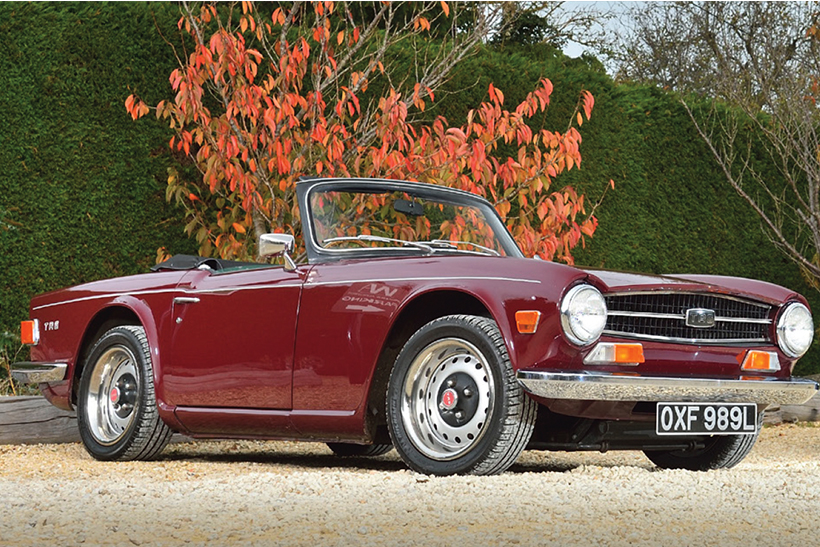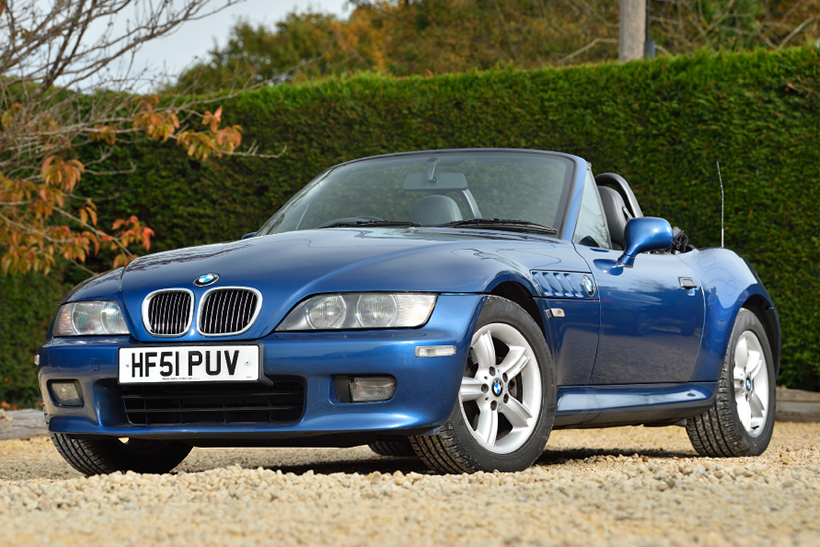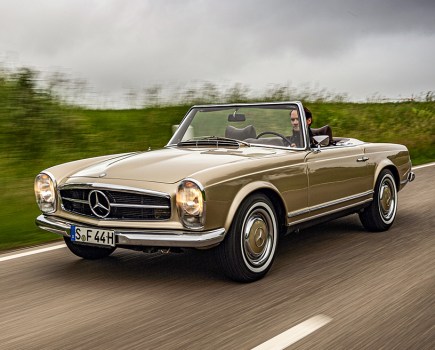Welcome to Old School vs New School where we visit the controversial subject of traditional classics compared to their more youthful equivalents. This time, the Triumph TR6 versus the BMW Z3…
Just as today’s paper is tomorrow’s chip wrappers, so each modern classic will eventually take its accepted place in the line-up of cherished classics at a car show of the future and we’ve picked another selection we reckon offer a good illustration of the changing tastes.
If you wish you’d cashed in when a 911 was yours for £8000 or even when an E-Type was £500 then here’s your second chance.

OLD SCHOOL – TRIUMPH TR6
TECH SPEC
Engine: 2498cc
Power: 150bhp
Top speed: 121mph
Fuel consumption: 20mpg
Gearbox: four-speed man o/d
The blunt, at the time considered un-elegant, shape of the TR6 speaks volumes today – it’s gained the reputation of being a bit of a bar room brawler with a gritty straight-six packing all the punches. And it’s this no-fuss, rugged British sports car appeal that’s made it now very desirable. It might seem odd then when we reveal that it was German coachbuilder Karmann who was given the task of carrying out a budget makeover to create a more modern looking car, based on the TR5. Nothing was done to the centre section, but new front and rear panels were fitted to make it look radically different, with lights now in the corners of the wings and the boot featuring a Kamm tail. A prototype appeared in 1968, with the first production car hitting the streets in 1969.
In common with its predecessor, UK cars featured fuel injection, while US cars had to make do with twin carbs. Rostyle wheel covers were fitted as standard and the windscreen surround was painted the same colour as the body, although by 1970 it became matt black. A steering lock was introduced in 1971 and at around the same time, Triumph borrowed the Stag gearbox for better spaced ratios.
In 1973 a reprofiled camshaft was fitted to make the six-cylinder 2498cc engine more refined, but power dropped to 125bhp as a result. In the same year, wire wheels were scrubbed from the options list and the ‘J’ type overdrive replaced the earlier ‘A’ type unit.
Production finally came to a halt on 15 July 1976, by which point the total had reached 91,850.
WHAT’S THE APPEAL?
Handling is, as you would expect, along the lines of a traditional British sports car – you sit low and the ride’s firm but it’s predictable and surprisingly precise thanks to the addition of a front anti-roll bar and wider wheels. Overdrive was optional and worthwhile, transforming the TR6 into a proper long-distance cruiser, and making it a tad more frugal to boot. It’s reasonably rapid, too, with 60mph being reached in a little over eight seconds and lots of useful overtaking torque on sporting A-roads. But these aren’t the only reasons to buy a TR6; due to a huge choice of upgrades, satisfyingly it’s a car that can easily be tailored to your exact specification.
OWNING THEM
The good news is the back-to-basics Triumph is simple to own and service yourself and a raft of part suppliers will make keeping one in rude health inexpensive. There’s huge club and specialist support, too. As we’ve mentioned, however, the real pleasure
with ownership will be putting your own spin on your car. There’s a large number of relatively inexpensive modifications available to enable you to customize your TR6 to your own specification, from simple spin-off oil filter conversions to fitting a detachable steel hardtop which will convert it into a cosy coupé.
BUYING THEM
- Body condition is all-important – you can easily spend £2,000 on superficial repairs alone.
- Scuttle tops, wings, front bonnet seams, sills, boot lips and chassis trailing arm mounts are notorious rust spots.
- End float isn’t good – it means the thrust washer’s probably failed. • Look for oil pressure of between 75- 80psi at 3000rpm when warm.
- Jumping out of gear on the overrun will mean a replacement ‘box. Rebuilds start at £500.
- If you buy a less rusty import from a dry US state, expect to have to replace all the rubber bushes.
VALUES
For a car that split opinion in period, the sporty Triumph has undergone a huge reversal in fortunes because today it’s become more desirable than ever. A few years ago you could have picked up a project for £3000 but now the going price for a reasonable one is £12,000- £15,000. Because everyone prefers the 150bhp PI, often the post-’73 cars and carb’d US models with less power offer better value and with the passing of time, the difference in performance is less noticeable anyway.
TRIUMPH TR6 INSURING
To cover a 1973 Triumph TR6 worth £18,000 you’re looking at £115 with £150 accidental damage, fire and theft excess through Adrian Flux. Quotes are based on a 45-year-old male, second vehicle. The car is garaged, covers 3000 miles a year and lives in an SP2 postcode. He has no claims or convictions, is a club member, and is employed as a marketing manager. Comprehensive cover quotes were supplied by Adrian Flux and include free legal cover and optional agreed value. You can get your own quote at Adrian Flux or on 0800 369 8590.

NEW SCHOOL – BMW Z3
TECH SPEC
Engine: 2171cc
Power: 167bhp
Top speed: 139mph
Fuel consumption: 30mpg
Gearbox: Five-speed manual
Launched in 1996, the American built Z3 was BMW’s response to the rapidly growing market for sports roadsters; in short, it was a posher version of the MX-5 and MGF.
t sat on the platform from the E36 Compact which features the less complex semi-trailing arm rear suspension inherited originally from the E30, albeit with a wider track and beefier anti-roll bar to allow the provision of a small boot. It wasn’t a hugely shrewd move as ironically the suspension has remained the most criticised aspect of the car to date.
All along, despite the availability of a six-cylinder 2.8-litre/3-litre version, BMW wanted to push the boundaries with an even more exotic version – and the 3.2-litre Z3 M Roadster fitted the bill perfectly. It made its debut, alongside the M Coupé, at the 1977 Frankfurt Motor Show and featured all the usual M Division niceties such as firmer springs and dampers, bigger brakes, ZF box with a limited slip diff and stylish 17in alloys. Air conditioning was supplied as standard throughout, along with leather upholstery.
There was a mild facelift in mid- 1999, followed by another revision in 2001 when the old E36 321bhp engine was swapped for the S54 325bhp unit from the new E46 M3. The model was replaced by the Z4 the following year.
WHAT’S THE APPEAL?
All the six-cylinder Z3 models are quick, the M Roadster terrifyingly so and the 2.8i and 3.0i not far behind. Pick of the bunch though is often said to be the 170 bhp 2.2i model. The steering is quick and responsive, and an almost perfect 50:50 weight distribution makes it handle impeccably. Okay, the ride can be harsh at times and that back end is still twitchy, but because it’s just so good in every other respect, that’s easily overlooked. It’s also well kitted out, beautifully finished and comfortable (as long as you’re not too tall).
The other attraction is that iconic ‘M’ badge; it’s a car that’s guaranteed to attract plenty of enthusiast attention in the years to come.
OWNING THEM
With economy on a par with the 3-Series saloons and many parts shared between them, the non-M Power models are easy to own. Moreover peerless reliability, strong build and the support of a dedicated Z-car register in the BMW Car Club (GB), will make ownership a rewarding experience. Because there’s a degree of crossover with the E36/46 most parts can be purchased via nationwide independent suppliers and there will be lots of scope to upgrade from the already high factory specification should you so wish.
BUYING THEM
• Listen for a tractor-like rumble from the double Vanos unit, although some noise is to be expected.
• S54 bearing shell failure is common on the M cars.
• The Z3 suffers electrical niggles, so make sure everything works as it should.
• Rust can be an issue, especially around the bottom rear of the front arches, sills and around the boot lock.
• The boot floor can rip where the diff is attached, so do a proper inspection.
• Check the power hood raises and lowers as it should.
VALUES
You wouldn’t expect a car with as much kudos as this going unnoticed for too long, and although the ‘cooking’ models are still good value, prices for the M Roadster have been steadily on the increase. Realistically you will need £15,000 to buy one, though we still think that’s massively undervalued. In fact, bang for your bucks it’s an absolute steal.
BMW Z3 INSURING
To cover a 2002 BMW Z3 2.2i worth £5000 you’re looking at £210 with £200 accidental damage, fire and theft excess through Adrian Flux. Quotes are based on a 45-year-old male, second vehicle. The car is garaged, covers 3000 miles a year and lives in an SP2 postcode. He has no claims or convictions, is a club member, and is employed as a marketing manager. Comprehensive cover quotes were supplied by Adrian Flux and include free legal cover and optional agreed value. You can get your own quote at Adrian Flux or on 0800 369 8590.
OLD SCHOOL VS NEW SCHOOL SERIES
Thinking of getting your hands on a modern classic car? Well keep an eye on Classics World for the next of our old school vs new school classics feature, where we will visit the controversial subject of traditional classics compared to their more youthful equivalents.







